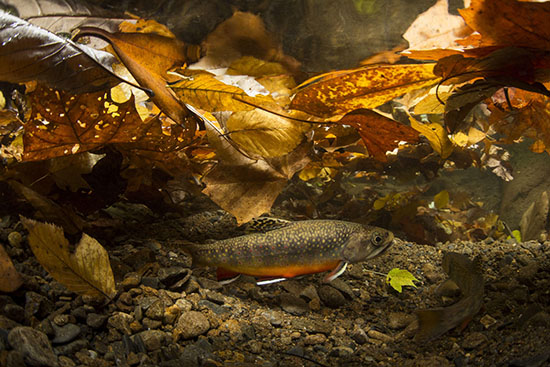By the Numbers: 23
The maximum temperature, in degrees Celsius, that brook trout can tolerate

In our watershed, a fish that is no more than 10 inches long is a sentinel of climate change. Because brook trout need cold, clean water to survive, their presence in the region’s headwaters is a sign of stream health. As urbanization and other factors have raised the temperature of streams across the region, scientists have documented the disappearance of this sensitive fish. But experts now believe future increases in stream temperature will be less uniform than once thought, marking a shift in our understanding of how climate change could impact the only native trout in the Chesapeake Bay watershed.
According to the Eastern Brook Trout Joint Venture, brook trout began to disappear from the region when early agriculture, timber and textile industries prompted the removal of forests and pollution of streams. Today, urbanization threatens remaining brook trout habitat: paved surfaces push sediment into waterways, while dams and poorly designed culverts isolate brook trout populations from one another. The large, non-native brown trout—which is often stocked in rivers and streams to support fly fishing—has also been found to out-compete brook trout.
However, the single most important factor in predicting whether brook trout will inhabit an area is water temperature. While individual brook trout populations can acclimate to regional water temperatures, brook trout experience stress when stream temperatures reach 20 degrees Celsius and are typically absent when temperatures exceed 23 degrees. Scientific consensus has placed the limits of brook trout survival between 0 and 23 degrees Celsius (about 32 and 73 degrees Fahrenheit).
In Maryland and Virginia, high water temperature has been named the greatest disturbance to brook trout populations. In light of this fact, the National Park Service and U.S. Geological Survey (USGS) have supported efforts to predict how climate change will impact brook trout habitat in two national parks in an attempt to resolve the uncertainties of our changing environment at a scale that would be relevant to natural resource managers.

Craig Snyder and Nathaniel Hitt are researchers at the USGS Leetown Science Center. Through field work in Shenandoah National Park and statistical modeling and simulation, Snyder and Hitt found that climate change would not affect brook trout habitat in the way previous research has largely assumed. Instead, the localized upwelling of cold groundwater into streams will create a varied pattern of stream temperatures and a patchy distribution of suitable brook trout habitat.
“We’ve learned that you need to account for groundwater to anticipate stream responses to climate change,” Snyder said. “The future will be more complicated—and thermally fragmented—than prior research has recognized.” In other words, as the region experiences more widespread effects of climate change, the temperature-related fragmentation of brook trout habitat will play a bigger role in determining the viability of the region’s brook trout populations.
While accounting for the effects of cold groundwater on stream temperature make Snyder and Hitt’s predictions less pessimistic than some others, all of their scenarios predict habitat loss in Shenandoah National Park. “The general consensus is that a 1.5-degree Celsius increase [in the region’s mean annual air temperature] is unavoidable. The question is, will we hit 5 degrees Celsius? And if so, when?” Under such an increase, “basically all habitat [in the park] becomes unsuitable, regardless of groundwater effects,” Hitt said.
“Our research indicates that stream warming will not proceed in a systematic or spatially uniform way,” said Snyder. “It’s going to more closely resemble a shattering of thermal habitat than a systematic change.”

Just what this “shattering” of suitable habitat will do to brook trout populations is unclear. While it is likely to diminish brook trout occupancy—or the presence of the fish in a particular area, which is used instead of the more variable abundance to determine the health of brook trout populations—some unknowns remain. For instance: what conditions will brook trout swim through in order to find suitable habitat? How much cold habitat is necessary for a self-sustaining brook trout population to thrive? And can local populations adapt to heat stress over time?
This kind of research could help our partners expand brook trout populations rather than merely holding onto the habitat that currently exists. If scientists find brook trout that have responded at an evolutionary level to heat stress, for example, they could use these populations to reintroduce fish to historically occupied habitat and, in turn, move closer to the Chesapeake Bay Watershed Agreement commitment to increase occupied habitat.
“This species has existed for millions of years,” Hitt said. “They’re survivors. A loss of a cohort in one year has little effect on population dynamics. But three or four back-to-back years of bad recruitment—that’s where the problem is. Our research helps us predict where brook trout populations will be more resilient to coming environmental changes.”
Snyder, Hitt and Zachary Johnson recently used remote sensing data to model the effects of groundwater on stream temperature. Their work showed that landform features and precipitation records can predict where groundwater affects fish habitat, and the results of this work have been mapped by the USGS Eastern Geographic Science Center.
“Our research shows that stream temperature data are valuable not only for understanding current thermal habitat conditions for brook trout, but also for anticipating future changes,” said Johnson. “Our work can help prioritize streams for long-term brook trout conservation.”
Learn more about the Chesapeake Bay Program’s work to restore and sustain brook trout in the region’s headwater streams.

Comments
There are no comments.
Thank you!
Your comment has been received. Before it can be published, the comment will be reviewed by our team to ensure it adheres with our rules of engagement.
Back to recent stories